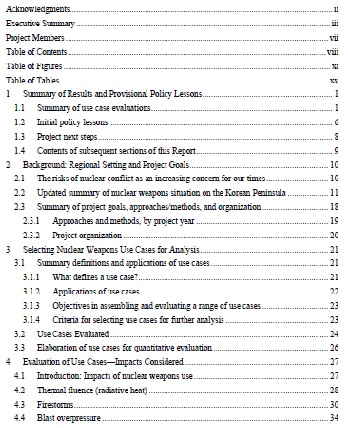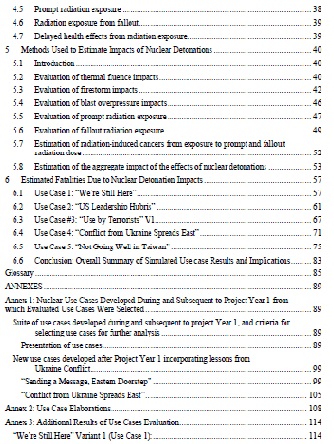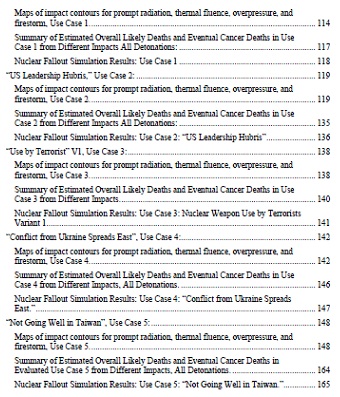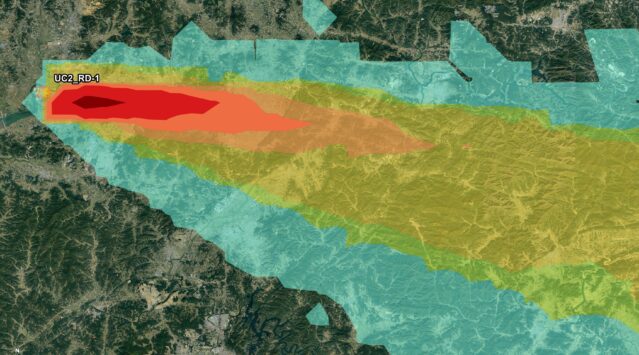DAVID VON HIPPEL, EVA LISOWSKI, PETER HAYES, SHATABHISHA SHETTY, TATSUJIRO SUZUKI, FUMIHIKO YOSHIDA, MICHIRU NISHIDA, STEVE FREEDKIN
MARCH 31 2023
I. INTRODUCTION
This report summarizes the second year of work on estimating the humanitarian impacts of nuclear war in Northeast Asia. Based on five of the thirty plausible nuclear use cases developed in year 1 (see report here), the year 2 report produced quantitative estimates of the likely direct deaths and delayed cancer deaths resulting from nuclear weapons use. Even in the most limited of nuclear conflicts, deaths were in the tens or hundreds of thousands, with the more extensive conflicts resulting in millions of deaths and hundreds of thousands of cancer deaths. The report suggests a number measures to reduce the risk of choosing or stumbling onto one of these pathways by developing and applying regional and global policy measures such as increasing transparency of nuclear stockpiles, deployments, and operational and declaratory doctrine—especially relating to integration of nuclear firestorms into nuclear targeting—such as increasing communications with nuclear hotlines as well as reducing the role of nuclear weapons in international affairs by introducing a nuclear no-first threat norm; resolving regional conflicts; and, ultimately, establishing a regional security framework including denuclearization of the Korean Peninsula and a nuclear weapon free zone in the region towards elimination of nuclear weapons altogether.
The full year 2 report (English) is found here (PDF, 27.6MB)
The Executive Summary is provided below in English and here, Chinese here Japanese here Korean here Russian here (live PDF file links)
This report is a part of a joint project on Reducing the Risk of Nuclear Weapon Use in Northeast Asia (NU-NEA) and has been cross-posted by the Asia Pacific Leadership Network here, and the Research Center for Nuclear Weapons Abolition (RECNA) and the Panel on Peace and Security of North East Asia (PSNA) here
Acknowledgements: Ted Postol and Lynn Eden provided advice and documentation related to this report with regard to nuclear firestorms. Noboru Takamura, Atomic Bomb Disease Institute, Nagasaki University provided scientific advice on radiation health impacts of the nuclear explosions at Hiroshima and Nagasaki. Copyediting by Maureen Jerrett.
The views expressed in this report do not necessarily reflect the official policy or position of the Nautilus Institute. Readers should note that Nautilus seeks a diversity of views and opinions on significant topics in order to identify common ground.
This report is published under a 4.0 International Creative Commons License the terms of which are found here.
Acknowledgement: This project is funded by Nagasaki University, APLN, the Nautilus Institute, the John D. and Catherine T. MacArthur Foundation, the New Land Foundation, and the Samuel Rubin Foundation
Banner image: Fallout radiation exposure map from a detonation at Camp Humphries, ROK. Source: HYSPLIT/QGIS simulation by Eva Lisowski and David von Hippel, Nautilus Institute.
II. NAPSNET SPECIAL REPORT BY DAVID VON HIPPEL, EVA LISOWSKI, PETER HAYES, SHATABHISHA SHETTY, TATSUJIRO SUZUKI, FUMIHIKO YOSHIDA, MICHIRU NISHIDA, STEVE FREEDKIN
HUMANITARIAN IMPACTS OF NUCLEAR WEAPONS USE IN NORTHEAST ASIA: IMPLICATIONS FOR REDUCING NUCLEAR RISK
MARCH 31 2023
Executive Summary
The risk of nuclear war—that is, the risk of attacks carried out by detonating nuclear weapons, hereafter “nuclear weapons use”— as of early 2023 is judged by many observers to be at its highest since the end of the Cold War. This risk is increasing due to nuclear threat-making during the Ukraine conflict, the India-Pakistan conflict, the Korean conflict, and the Middle Eastern conflict. Northeast Asia represents one of four potential flash points where nuclear weapons might be used for the first time since the last time they were used, on Nagasaki on August 9, 1945—hereafter called “first use” in this report.[1]
Northeast Asia includes two nuclear weapons states (China and Russia), a third nuclear weapons state with a key presence as a guarantor of security (the United States), a fourth and more recent self-declared, if not universally accepted, nuclear-armed state (the Democratic People’s Republic of Korea, or DPRK), and two non-nuclear weapons nations under the US “nuclear umbrella” with the technology to produce nuclear weapons and at least some voices arguing for access to or ownership of nuclear weapons (the Republic of Korea, or ROK, and Japan). Add to this group of actors the long-simmering and occasionally boiling issue of nuclear weapons on the Korean Peninsula, tensions over Taiwan, and other regional disputes, and a number of potential nuclear weapons “use cases” become plausible.
The second year of the Project on Reducing the Risk of Nuclear Weapons Use in Northeast Asia (NU-NEA), set out to better understand the risks of nuclear weapons use in the region. To this end, we produced quantitative estimates of the likely direct deaths and delayed cancer deaths resulting from nuclear weapons use. Five different nuclear “use cases” were simulated and analyzed. The hypothesized use cases were designed to be plausible, span a range of outcomes from a single detonation to limited global nuclear war, and include a range of nuclear actors and targets initiated in Northeast Asia, involving the Korean Peninsula, and in some cases spreading to other regions or continents. The estimated deaths and radiation-induced cancers resulting from the following six impacts were evaluated:
- Thermal fluence (heat) from nuclear blasts.
- Firestorms: multiple fires lit by thermal fluence that coalesce into large-area conflagrations encircled by hurricane-force winds as the heat rising from the fires pulls cooler air in behind it. Physical damage caused by blast overpressure provides fuel for firestorms, which could burn for weeks.
- Blast overpressure, causing building damage and collapse.
- Prompt radiation from the nuclear detonation itself.
- Fallout radiation, as radioactive material from the blast and contaminated debris are spread by wind and rain.
- Radiation-induced cancer deaths suffered by those exposed to prompt and fallout radiation but not killed by the nuclear blast immediately or in the short term (within several months to a year).
Out of the 30 plausible use cases developed in Year 1 of the NU-NEA project, five use cases were simulated and evaluated quantitatively:
- “We’re Still Here” Variant 1, involving nuclear weapons use by the DPRK followed by the United States, with 3 total detonations of 10 kT (kiloton) and 8 kT weapons.
- “US Leadership Hubris,” involving first nuclear weapons use by the United States, followed by use by the DPRK, and China, with 18 total detonations ranging in yield from 8 to 300 kT.
- “Use by Terrorists” Variant 1, with one 10 kT weapon detonated by a terrorist group.
- “Conflict from Ukraine Spreads East,” involving first nuclear weapons use by Russia and followed by the United States, totaling eight detonations of 8, 150, and 200 kT weapons.
- “Not Going Well in Taiwan,” involving first nuclear weapons use by China followed by responses from the United States, with a total of 24 detonations ranging in yield from 8 to 300 kT.
The table below summarizes the estimated prompt and short-term deaths and radiation-induced cancer deaths resulting from the impacts above for each of the five use cases evaluated. Even in the most limited of nuclear conflicts, deaths were in the tens or hundreds of thousands, with the more extensive conflicts resulting in millions of deaths and hundreds of thousands of cancer deaths. It should be noted that even the most extensive conflicts evaluated here were halted short of an all-out exchange of intercontinental nuclear missile attacks, but certainly could have ended that way. In the table below, “prompt” deaths are those caused by physical damage or fires in the immediate aftermath of detonations, including victims not killed immediately but dying within days or weeks, and “short-term” deaths include victims who succumbed to their injuries within the year following the nuclear attack.
Estimated Likely Direct and Cancer Deaths in Each of Five Modeled Use Cases[2]

These results show that use cases that include many high-yield (50-300 kT) airbursts result in a higher relative impact, roughly 35% lethality, than use cases with a limited number of detonations or with mostly surface-bursts, which average roughly 25% lethality. As a conflict escalates, especially when progressively larger nuclear detonations target more populated areas, the humanitarian impacts of a nuclear conflict not only increase, but often grow by orders of magnitude. One contributing impact is the occurrence of deadly firestorms resulting from high- yield weapons detonated as airbursts that cause far-ranging thermal fluence, demonstrating that firestorms can be a significant contributor to the lethality of nuclear weapons. Furthermore, even use cases with a limited number of surface-bursts or using weapons of relatively low yield can cause a disproportionately high number of fatalities when acute health effects from high radiation doses and long-term cancer deaths are considered.
In Use Case 3, for example, a single surface-burst in an urban area results in estimated cancer fatalities on the same order of magnitude as the limited global nuclear war cases shown in Use Cases 2 and 5. The death toll in the short-term from exposure to high fallout radiation could also be the same or higher in Use Case 3, even though only one nuclear weapon has been detonated in an urban area. This result emphasizes how unpredictable the long-term and health impacts of nuclear use cases can be because it is nearly impossible to foresee whether a conflict will end after one detonation, 18 detonations, 24 detonations, or more, and whether urban areas will be targeted. Even when the conflict does not escalate to global nuclear war, it is possible that impacts consistent with those expected in a global-scale nuclear war can be felt after only one nuclear detonation.
In addition to devastating losses of human life, a range of economic and societal impacts, such as billions of dollars in infrastructure damage and health care costs, and a further set of global, regional, and local ecological impacts such as climate effects or effects on oceans, would also result from these use cases. The evaluation of these and other impacts will be addressed in the third project year.
The use cases evaluated in the NU-NEA project are intended to be plausible, but they capture only a small fraction of the possible pathways to nuclear war and its consequences identified in this project, which in turn do not even begin to encapsulate the universe of possible ways that a nuclear conflict could start and play out. Several conclusions, however, can be drawn from the limited number of use cases evaluated in this project:
- A nuclear conflict based on regional issues can escalate to a global nuclear conflict within hours or days after the first use of nuclear weapons.
- Any nuclear detonations, even in relatively unpopulated areas, are likely to result in at least thousands of deaths, with possible fallout crossing international borders, causing additional health risks and increasing political tensions even when fallout levels are low.
- Even when focused on military targets, nuclear detonations may kill many hundreds of thousands of people within days or months, as well as cause hundreds of thousands of additional cancer deaths and great economic damage.
- The impact of mass fires or firestorms that sometimes result from nuclear explosions can surpass the lethality of other direct impacts of nuclear use. Historically, military planning for nuclear use has lacked sufficient consideration of firestorm impacts.
- Many of the plausible nuclear use cases developed for this project have their genesis in misinterpretation of intentions and lack of communication between adversaries, underscoring the need for communication between nations to avert nuclear weapons use, especially during times of conflict and crisis.
- There are many plausible pathways to nuclear war that would have cataclysmic effects. Most of these pathways involve “slippery slopes” of descent into nuclear war, where an action by one party is misinterpreted by another, leading to conflict escalation that proceeds further and more rapidly than adversaries intend or foresee. As such, these potential pathways to nuclear war are often invisible to policymakers.
- It is urgent to reduce the risk of choosing or stumbling onto one of these pathways by developing and applying regional and global policy measures such as increasing transparency of nuclear stockpiles, deployments, and operational and declaratory doctrine—especially relating to integration of nuclear firestorms into nuclear targeting—such as increasing communications with nuclear hotlines.
- In addition, it is important to explore policy measures to reduce the role of nuclear weapons in security policy and to revive arms control and disarmament diplomacy. Such measures include introducing a nuclear no-first threat norm; resolving regional conflicts; and, ultimately, establishing a regional security framework including denuclearization of the Korean Peninsula and a nuclear weapon free zone in the region towards elimination of nuclear weapons altogether.
TABLE OF CONTENTS



III. ENDNOTES
[1] There is no legal or institutional definition of Northeast or East Asia. The United Nations Economic and Social Commission for Asia and the Pacific (UNESCAP) uses “East and North East Asia (ENEA) to refer to “China; Democratic People’s Republic of Korea; Hong Kong, China; Japan; Macao, China; Mongolia; Republic of Korea”. See UNESCAP (undated), “4 List of countries in the Asia-Pacific region and subregions”, available as https://data.unescap.org/dataviz/methodology/list-of-countries-in-the-asia-pacific-region-and-subregions.html
An examination of the contested usage related to “Asia” and its sub-regions is found in P. Hayes and C.I. Moon, ed (2018), The Future of East Asia, Palgrave MacMillan, available at: https://link.springer.com/book/10.1007/978-981-10-4977-4
[2] Note that Individual impacts in this table may not add up to the exact total shown in column five due to rounding.
IV. NAUTILUS INVITES YOUR RESPONSE
The Nautilus Asia Peace and Security Network invites your responses to this report. Please send responses to: nautilus@nautilus.org. Responses will be considered for redistribution to the network only if they include the author’s name, affiliation, and explicit consent


